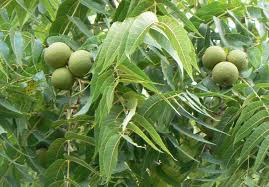Recently, a question about using black walnut chips for mulch was posted on our Garden Professors Facebook group page. As gardeners know, black walnut has a reputation as a chemical warfare species that will kill anything growing underneath it – a phenomenon called allelopathy. So it’s logical to wonder about the lethality of walnut chip mulches.
To get a good feel for the science behind black walnut’s allelopathic abilities, I was fortunate to find a relatively recent review on the topic (Willis, R.J. 2000. Juglans spp., juglone and allelopathy. Allelopathy Journal 7(1):1-55.). This well-written review includes a fascinating section on the historical background of walnut allelopathy, which was first mentioned in 36 BC by the Roman author Varro. But the science of allelopathy really started less than 100 years ago, when a Virginia researcher noticed the injury caused to tomato plants growing near black walnut (Juglans nigra) in his home garden. Subsequent experiments by him and others suggested that the orangish hydroquinone juglone leaching primarily from leaf litter and hulls.
The research results on walnut, juglone, and allelopathy have been nothing if not inconsistent. For every report of toxicity in an exposed species, another report found no effect. In fact, much of the supposed allelopathy might instead be due to walnut’s highly competitive root systems, which could suck up available water and nutrients over a vast expanse of soil.
There are a number of other factors that help account for ambiguous results:
1) Juglone is not the only secondary metabolite produced by walnut species. They are loaded with a number of untested phenolics, flavonoids, alkaloids, terpenes and other quinones which could have allelopathic activity.
2) Juglone concentrations vary greatly among walnut species. They also have seasonal variability in the same individual.
3) Light conditions, rainfall, soil chemistry, and many other abiotic factors can influence juglone levels.
4) Organic matter and clay particles in soils can bind juglone, reducing its movement within the soil.
5) Microbial activity breaks down juglone.
Carefully controlled laboratory experiments can demonstrate juglone allelopathy to a number of plant species, especially at the seedling stage. However, there is little evidence from landscape level research to suggest that allelopathy is the reason that plants are damaged by being in proximity to walnut trees. In fact, the author of the review study concludes that even though Juglans species provides the best known and most widely accepted example of allelopathy, there is “still is no unambiguous demonstration of its effect” as “no one has as yet demonstrated that juglone is actually taken up by plant roots.”
Where does this lead us in our discussion of walnut mulch toxicity? Fresh hulls and leaves appear to be the primary source of allelopathy, but not the wood. And even these sources may be quickly neutralized by soil conditions. Therefore, a walnut chip wood mulch should pose no danger at all to landscape plantings.



I am a wood worker and recently planed boards from 3 walnut trees to make lumber for projects. I composted the wood shavings and used them exclusively around plants that were native and I thought would have a natural immunity to the poison. Specifically, I used it around Mountain Laurel and galax near Asheville, NC. I have not seen any ill effects where used.
That top photo certainly doesn’t look like a black walnut.
I’m curious of the authors thoughts on using black walnut mulch for paths between raised beds? I was curious of the permeation of julgone into surrounding soil and whether or not leaching may occur up into the raised bed. Potentially using the mild toxicity to our advantage…?
If you have a healthy, living soil, you aren’t going to have much juglone persist there. There is solid evidence that it’s broken down quickly by microbes.
You may also want to look at a recent publiction calling into doubt the phenomenon of allelopathy in landscapes. https://pubs.extension.wsu.edu/do-black-walnut-trees-have-allelopathic-effects-on-other-plants-home-garden-series